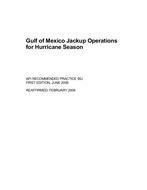No products
 View larger
View larger
API RP 95J (R2020)
M00043606
New product
API RP 95J (R2020) Gulf of Mexico Jackup Operations for Hurricane Season - Recommendations, First Edition
standard by American Petroleum Institute, 06/01/2006
Full Description
The purpose of this recommended practice is to present an approach to siting Jackup Mobile Offshore Drilling Units (MODUs) and to recommend certain operational procedures to enhance Jackup survivability and stationkeeping during hurricane season in the Gulf of Mexico during drilling, workover and while stacked (idled) at a non-sheltered location. This RP provides guidance and processes and when combined with an understanding of the environment at a particular location, the characteristics of the unit being utilized, and other factors, may be used to enhance operational integrity. This RP was developed through a cooperative arrangement with the International Association of Drilling Contractors' (IADC) Jackup Rig Committee. Specifically, this RP provides guidance in the following areas:Site - including location-specific, geotechnical, and metocean;Preloading Process;Air Gap Recommendations;Unit Preparations and Evacuation;Post Storm Recovery;and Post Storm Inspections.In stock
More info
Gulf of Mexico Jackup Operations for Hurricane Season
API RECOMMENDED PRACTICE 95J FIRST EDITION, JUNE 2006
REAFFIRMED, SEPTEMBER 2020
Gulf of Mexico Jackup Operations for Hurricane Season
Upstream Segment
API RECOMMENDED PRACTICE 95J FIRST EDITION, JUNE 2006
REAFFIRMED, SEPTEMBER 2020
Special Notes
API publications necessarily address problems of a general nature. With respect to particular circumstances, local, state, and federal laws and regulations should be reviewed.
Neither API nor any of API's employees, subcontractors, consultants, committees, or other assignees make any warranty or representation, either express or implied, with respect to the accuracy, completeness, or usefulness of the information contained herein, or assume any liability or responsibility for any use, or the results of such use, of any information or process disclosed in this publication. Neither API nor any of API's employees, subcontractors, consultants, or other assignees represent that use of this publication would not infringe upon privately owned rights.
API publications may be used by anyone desiring to do so. Every effort has been made by the Institute to assure the accuracy and reliability of the data contained in them; however, the Institute makes no representation, warranty, or guarantee in connection with this publication and hereby expressly disclaims any liability or responsibility for loss or damage resulting from its use or for the violation of any authorities having jurisdiction with which this publication may conflict.
API publications are published to facilitate the broad availability of proven, sound engineering and operating practices. These publications are not intended to obviate the need for applying sound engineering judgment regarding when and where these publications should be utilized. The formulation and publication of API publications is not intended in any way to inhibit anyone from using any other practices.
Any manufacturer marking equipment or materials in conformance with the marking requirements of an API standard is solely responsible for complying with all the applicable requirements of that standard. API does not represent, warrant, or guarantee that such products do in fact conform to the applicable API standard.
All rights reserved. No part of this work may be reproduced, stored in a retrieval system, or transmitted by any means, electronic, mechanical, photocopying, recording, or otherwise, without prior written permission from the publisher. Contact the Publisher, API Publishing Services, 200 Massachusetts Avenue, NW, Suite 1100, Washington, DC 20001.
Copyright © 2008 American Petroleum Institute
Foreword
This recommended practice (RP) is under the jurisdiction of the API Upstream Executive Committee on Drilling and Production Operations (ECDPO) and was developed with guidance from and in cooperation with the International Association of Drilling Contractors’ (IADC) Jackup Rig Committee and the Offshore Operators Committee’s (OOC) Drilling Technical Subcommittee. Additionally, the Minerals Management Service (MMS) and the U.S. Coast Guard (USCG) provided general guidance and assistance in the development of the RP.
Nothing contained in any API publication is to be construed as granting any right, by implication or otherwise, for the manufacture, sale, or use of any method, apparatus, or product covered by letters patent. Neither should anything contained in the publication be construed as insuring anyone against liability for infringement of letters patent.
This document was produced under API standardization procedures that ensure appropriate notification and participation in the developmental process and is designated as an API standard. Questions concerning the interpretation of the content of this publication or comments and questions concerning the procedures under which this publication was developed should be directed in writing to the Director of Standards, American Petroleum Institute, 200 Massachusetts Avenue, NW, Suite 1100, Washington, DC 20001. Requests for permission to reproduce or translate all or any part of the material published herein should also be addressed to the director.
Generally, API standards are reviewed and revised, reaffirmed, or withdrawn at least every five years. A one-time extension of up to two years may be added to this review cycle. Status of the publication can be ascertained from the API Standards Department, telephone (202) 682-8000. A catalog of API publications and materials is published annually and updated quarterly by API, 200 Massachusetts Avenue, NW, Suite 1100, Washington, DC 20001.
Suggested revisions are invited and should be submitted to the Standards Department, API, 200 Massachusetts Avenue, NW, Suite 1100, Washington, DC 20001, standards@api.org.
iii
Contents
Page
Scope 1
Overview 1
Terms and Definitions 1
Site 3
Preloading Process 4
Air Gap 4
Unit Preparations and Evacuation 4
Post-storm Recovery 5
Post-storm Inspections. 5
Annex A 7
Annex B 9
Annex C 11
Annex D 13
Figures
A.1 Recommended Air Gap for Jackups in Hurricane Season 8
B.1 Jackup Hurricane Data Collection Form 10
D.1 Expected Wave Crest Elevation with Uncertainty 13
v

